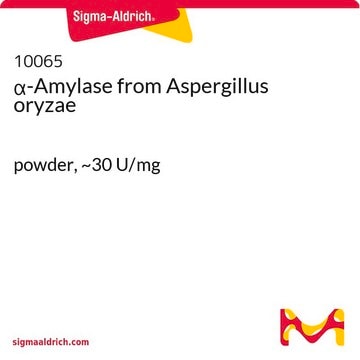A6380
αα-amilasa from Bacillus sp.
Type II-A, lyophilized powder, ≥1,500 units/mg protein (biuret)
Sinónimos:
1,4-α-D-Glucan-glucanohidrolasa
About This Item
Productos recomendados
biological source
bacterial (Bacillus amyloliquefaciens)
type
Type II-A
assay
≥30%
form
lyophilized powder
specific activity
≥1,500 units/mg protein (biuret)
mol wt
50-55 kDa by SDS-PAGE
technique(s)
SDS-PAGE: suitable
solubility
H2O: soluble 0.1 mg/mL, clear, colorless
suitability
suitable for hydrolysis, synthesis of oligosaccharides and polysaccharides, and sugar modification
application(s)
life science and biopharma
storage temp.
−20°C
¿Está buscando productos similares? Visita Guía de comparación de productos
General description
Application
- as a component of salivary fluid to perform artificial mastication; in luminal gastrointestinal digestion experiment
- as a standard in sodium dodecyl sulfate-polyacrylamide gel electrophoresis (SDS-PAGE) to determine the concentration of α-Amylase
- to de-starch the alcohol insoluble residue (AIR) for non-cellulosic neutral monosaccharide analysis
Biochem/physiol Actions
Features and Benefits
- α-Amylase from Bacillus licheniformis NCIB 6346 retains over 98% of its activity after 60 minutes at pH 6.2 and 85°C.
- Other α-Amylase maintain 100% of their activity after storage for 1 hour at 91°C.
Unit Definition
Preparation Note
Other Notes
substrate
signalword
Danger
hcodes
pcodes
Hazard Classifications
Resp. Sens. 1
Storage Class
11 - Combustible Solids
wgk_germany
WGK 1
flash_point_f
Not applicable
flash_point_c
Not applicable
ppe
dust mask type N95 (US), Eyeshields, Faceshields, Gloves
Certificados de análisis (COA)
Busque Certificados de análisis (COA) introduciendo el número de lote del producto. Los números de lote se encuentran en la etiqueta del producto después de las palabras «Lot» o «Batch»
¿Ya tiene este producto?
Encuentre la documentación para los productos que ha comprado recientemente en la Biblioteca de documentos.
Los clientes también vieron
Protocolos
Follow our procedure for the determination of alpha-Amylase activity. This enzymatic assay of a-Amylase guides you through the entire process and necessary calculations.
Nuestro equipo de científicos tiene experiencia en todas las áreas de investigación: Ciencias de la vida, Ciencia de los materiales, Síntesis química, Cromatografía, Analítica y muchas otras.
Póngase en contacto con el Servicio técnico










